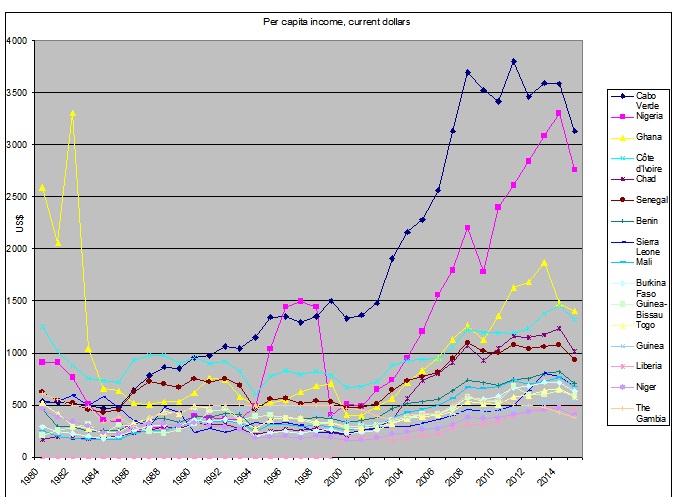Dec 2, 2015
West
African Income Growth Comparison
Source:
International Monetary Fund, World Economic Outlook Database, November
2015
Per Capita Income, Current US$
| Country | 1980 | 2015 | % change |
| Benin | 461.169 | 708.987 | 54 |
| Burkina Faso | 291.201 | 631.372 | 117 |
| Cabo Verde | 541.435 | 3,127.28 | 478 |
| Chad | 167.345 | 1,010.55 | 504 |
| Côte d'Ivoire | 1,256.06 | 1,318.81 | 5 |
| The Gambia | 611.169 | 384.243 | -37 |
| Ghana | 2,591.64 | 1,401.44 | -46 |
| Guinea | n/a | 545.644 | n/a |
| Guinea-Bissau | 206.197 | 582.243 | 182 |
| Liberia | n/a | 469.086 | n/a |
| Mali | 250.19 | 672.226 | 169 |
| Niger | 461.461 | 403.441 | -13 |
| Nigeria | 911.133 | 2,758.41 | 203 |
| Senegal | 620.162 | 934.643 | 51 |
| Sierra Leone | 510.92 | 675.18 | 32 |
| Togo | 518.773 | 578.11 | 11 |
There are sharp peaks and troughs, no doubt caused by war, currency devaluation and other socio-economic crises, but the chart and table above turn up some interesting results. The highest income earners are in Cape Verde, a small economy, followed by Nigeria, the largest economy. These are followed by Ghana, Ivory Coast, Chad (technically in Central Africa) and Senegal. The Chadian case points up the dangers in looking only at GNP per capita figures in assessing a country's development. The country has been associated for years with war, political instability, corruption, dictatorship and, yes, poverty. And yet it ends up in the first tier of the countries surveyed. In 1980 Chadians were by some distance the poorest of the countries studied and stayed at or close to the bottom of the list until 2003, when their growth spurt began. Upon closer investigation, this coincides exactly with commencement of oil production by a consortium of international oil companies. It's unclear whether the money flowing in from the oilfields is actually benefitting ordinary Chadians.
There is a gap between these top six earners and the balance nine which are all grouped close together in the $400 to $700 region. Interestingly, these top six high earners, with the exception of Cape Verde, really only started pulling away from the rest around the turn of the century. In 2000 Gambia and Senegal had approximately the same per capita income. By 2015, the IMF estimate was that Senegalese were earning almost 2.5 times their Gambian neighbours. What caused this growth spurt by the high earners should be a worthwhile topic for further study. The Gambia, sometimes thought of as something of a success story under Yahya Jammeh shows a very different picture in these statistics. It's one of three countries that actually showed a decline in per capita income during the 35-year period (Ghana's case is perhaps due to the instability of the period of military rule), and ends up at the bottom of the list of West African income.